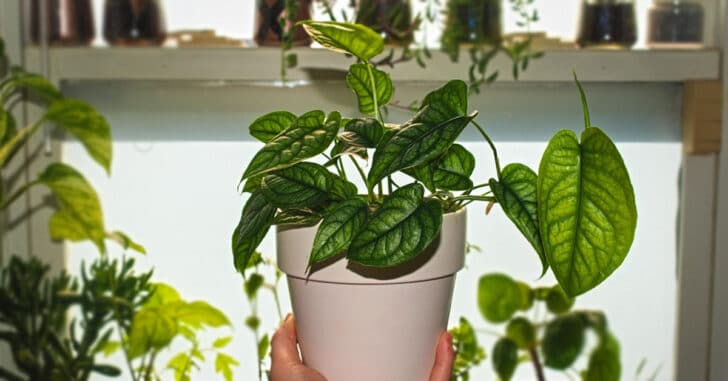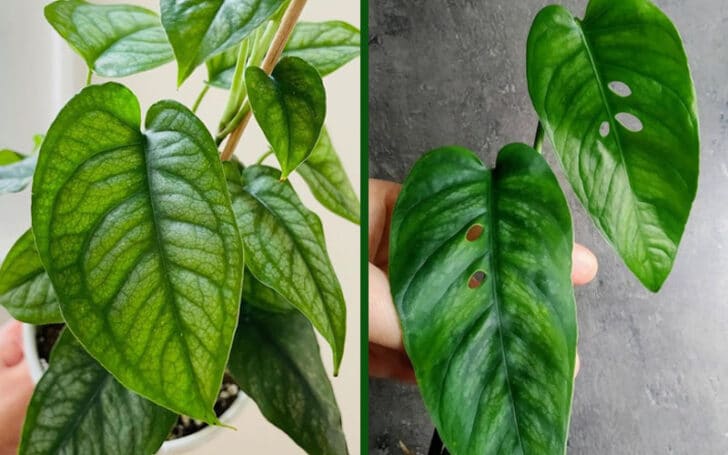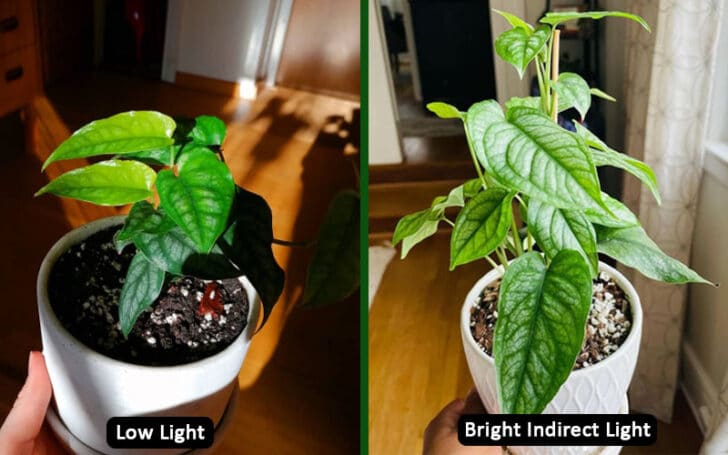Garden
This Monstera Siltepecana Care Guide Works (We Have 9 Simple Steps to Prove It)
If you are interested in cheaper, but rare and rare Monstera plants, we recommend purchasing this easy-care and fast-growing Monstera siltepecana.
Let’s be real: We all want to buy forgiving houseplants that can grow on their own, meaning they bless our home with their beautiful presence but demand occasional care in return.
And this unique siltepecana is one such plant.
“Yes, we are plant lovers, but we are also lazy people!” – said every plantaholic ever.
Here we provide an effective and simple Monstera siltepecana care guide for every lazy plant owner.
First, let’s learn about the origin and other details of this unique monstera species.
Table of Contents
Monstera Siltepecana
It can be a climber, a trailing plant, or your favorite evergreen hanging houseplant.
Monstera siltepecana or silver monstera, belonging to the Araceae family, originates from Mexico and Central America.
The characteristic feature of this monstera vine, which can be used all year round, is its unique foliage.
An infant or young siltepecana shows terrestrial growth. It has silvery-gray leaves with dark veined stripes.
Against this,
Mature monstera siltepecana becomes an epiphytic climber. It has distinctive green leaves with holes on the surface (monstera fenestration).
Now the care part:
How Do You Care for Monstera Siltepecana?
The evergreen vine of a silver plant is a rare but less expensive species of monstera that requires little care and maintenance.
It can thrive in any area indoors or outdoors with minimal care. The best USDA hardiness zone 9b-11 for growing the plant outdoors all year.
Here is the basic care of rare monstera for growing indoors:
Light: Bright to medium indirect sunlight (can tolerate low light but grows slowly)
Temperature: 13°C (55°F) to 29°C (85°F)
Humidity Level: 60% to 90%
Watering: Water every 7-10 days (always check for soil dryness)
Soil: A mixture of orchid bark, perlite and peat moss and any aroid soil
Propagation: Easy propagation in water, soil, sphagnum moss
They are not as demanding as Alocasia zebrina which means you can have a beautiful plant even with minimal maintenance routine.
Get all the info below:
1. Placement & Light
Preferred monstera sunlight is bright to medium. Place them where they can get enough indirect light.
They will grow well on an east-facing window side.
But can monstera get full sun?
Yes, siltepecana can handle direct sunlight, but only if the timing is not extended. Otherwise, the leaves will burn or scorch.
This window plant can even tolerate low light situations (partial or full shade), but be aware that this will affect their growth and leaf size.
Monstera Siltepecana isn’t a tough plant, but what if it’s not getting enough light for full growth? will he die?
Well, it’s not right there, but you may see small leaves and less growth from a siltepecana provided with full bright sunlight.
Proper lighting is one of the most important care steps for a fully grown, broadleaf Monstera siltepecana!
2. Watering
This monstera strain is not difficult when it comes to watering it.
It is a tropical plant of course, but as they get older they become more like epiphytes which means they like to be watered, but they don’t like that you over-water them, making the soil soggy and wet.
So how do you know if your monstera needs water?
Herbalists advised against sticking to a regular schedule when deciding to water the monstera. Instead, feel the dryness or wetness of the soil to choose when they should water.
If underwatered, leaves may appear wrinkled or drooping.
How to water monstera siltepecana now?
Water your plant thoroughly until it begins to drain from the drainage hole of the monstera pot.
You may notice some sweating (drops of water) on your monstera siltepecana the day after watering, but don’t panic. It’s just the way to get rid of excess water.
Do you have an ideal watering routine?
The optimum watering routine for this silver plant depends on where you live. For example, if they are placed in a dry environment, they will need frequent watering.
Whereas, if it is placed in a humid place, you can water it every 7 to 10 days.
Note: Do not allow the soil to dry completely between watering sessions. Instead, always keep it slightly moist (not wet). Check out the top 3; If it’s feeling dry, it’s time to water these monsters!
“Oh, I did it again! I forgot to water” person
It can survive for days without water as long as its lighting requirements are met. (We’re not motivating you to water it less, but that’s a bonus point. :p)
3. Temperature
Silver monstera plants are not sensitive to a particular temperature range, but will thrive in a warm, warm, tropical terrarium environment.
The ideal monstera temperature would be between 13°C (55°F) to 29°C (85°F). It will do well below 10°C (50°F) or up to 35°C (95°F).
Monstera Siltepecana Pronunciation
Mon-STER-uh so-to-picanha. Although it is an easy plant to care for, some people confuse its pronunciation. Mon_STER-uh is pronounced so-to-picanha
4. Humidity
Monstera Siltepecana plants prefer a moist environment.
We can say that they will grow very well in a bright room with a humidity of 60-90%. In fact, almost all monstera, except monstera obliqua, perform relatively well in an average humidity (50%) environment.
If you live in a low humid place:
- Add a humidifier around it
- Place a pebble tray filled with water beneath your plant
- Mist the leaves regularly
or
- You can even put it in your bathroom as long as they get their daily bright indirect light.
Choose the one that suits you and your monstera!
5. Soil
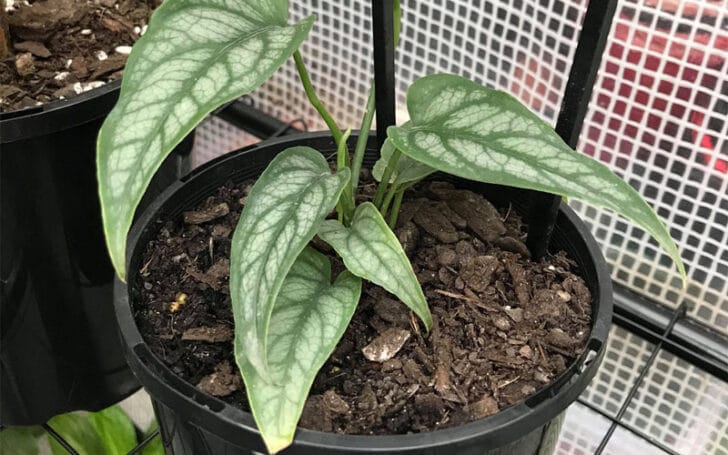
Like other species of the Monstera genus, this plant requires a well-drained soil mix to grow and develop fully. The best soil may be an aroid substrate such as 3 parts potting soil, 1 part perlite and a handful of orchid bark.
Since the roots of Monstera siltepecana plants are somewhat epiphytic, they do not like to sit in dense and heavy soils.
The light soil mix will allow air to flow up to the upper leaves of the plant and will also protect the monstera from root rot.
Note: Your precious monstera does not like mushy, wet, dry, wet or dense dense soil. (Nothing much! All he wants is light, free-draining, moist soil.)
6. Fertilizer
You don’t need to fertilize your Siltepecana too much, but be sure to dilute it to ½ strength when you do.
Any houseplant fertilizer mixed with water can work for these forgiving plants.
Siltepecana needs to be fertilized three times a month in summer and once in winter, according to monster lover Erika Lodes.
Expert Tip with Professional Guide
If you live in a location with no sun during the winter, you can skip fertilizing your silver plant altogether during the cold season.
7. Repotting
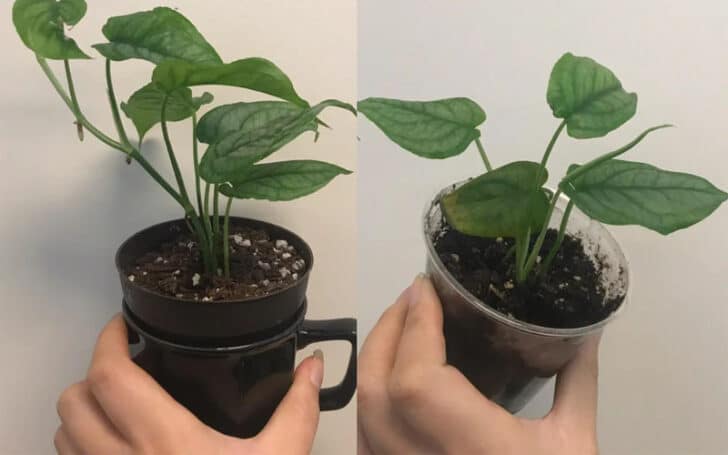
We’ve all heard that repotting houseplants from time to time is ideal for them to grow. Every plant lover will agree, but every species has individual needs, right?
How do you know when to change a monstera’s pot?
The first and most important symptom is the observation of overgrown monstera roots protruding from the drainage hole in the pot in which they were planted.
The other clue may be their slow growth, as is often the case when the plant is root-bound.
And you guessed it right, monstera plants don’t like to have enough room to grow freely, and as we’ve said before, they need airflow for proper growth.
So, No! No to root, friends!
The ideal potting material for Monstera siltepecana is a 10-20 diameter and 10″ deep terracotta or clay pot.
Or, if you don’t want to water it regularly, you can store it in a plastic or ceramic flower pot.
Take your plant, carefully place it in a new pot filled with fresh potting mix.
Pro tip: Use a clutter-free mat to keep your place groundless when potting your Siltepecana.
Cover with a plastic bag for moisture and place in a bright (out of direct light) place. And you’re done! No dear!
Can you buy Variegated Monstera Siltepecana? Is it expensive?
You can find a mottled monstera online, but finding it can be quite difficult for some. Moreover, it can be expensive.
An authentic nursery will sell a variegated monstera for $500-5000. Therefore, if you want to buy monstera, you should prepare for it to be expensive as it is a variegated version of it.
But why is it so expensive?
The Swiss cheese plant or mottled monstera does less photosynthesis (produces chlorophyll) and takes a lot of skill and time to grow.
Also, it is a rare plant and its high demand increases its final cost.
8. Propagation
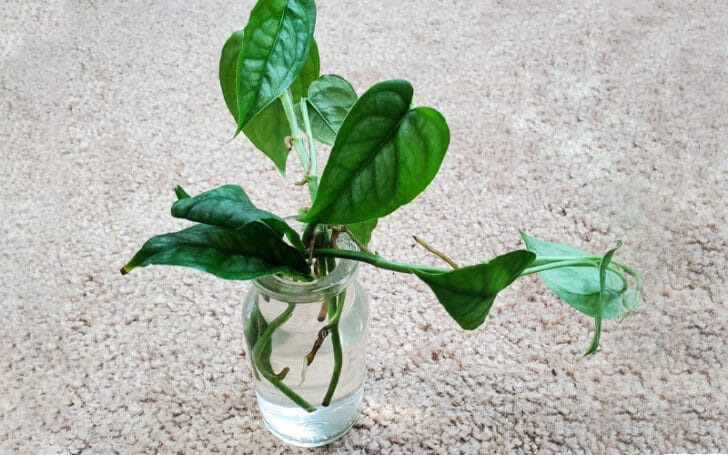
Monstera siltepecana is one of the easiest monsters to propagate. What’s the best part about Monstera propagation? Any method you choose has a high success rate:
The silver plant can be easily propagated by stem cuttings. Carefully cut (1-2 leaves) over the knot, take the cutting and place it in soil, warm water or sphagnum moss.
Cover it with a plastic bag to ensure adequate humidity and place it in a bright, warm place. Wait a few weeks and you will notice new roots growing.
Then transplant the roots into pots with fresh soil substrate. The rest of the care is similar to the parent siltepecana.
9. Monstera Growth Rate
Monstera silver plants are fast growers but need some support to mature into large nonstera plants.
To transform the baby siltepecana into a larger leafy version with Swiss cheese type (perforated) monstera leaves, attach a bamboo stick or stick to it. A mature monstera siltepecana may have 5 inch leaves.
What should you do if your Siltepecana has exceeded the monstera support bar?
Cut the knot and duplicate for a new plant.
Or,
Twist it into a loop for a beautifully designed container.
Other Similar Plants & Monstera Varieties
All monstera species, including mini monstera, are known for their holes in mature plants, often called Swiss cheese plants. And monstera siltepecana is no different!
For example,
Monstera epipremnoides, the other sibling of Siltepecana plants, also has large windowed leaves and requires minimal maintenance to thrive indoors.
and,
Another vine plant similar to Monstera siltepecana, Monstera Adansonii also displays lanceolate leaves with small holes.
They are also mixed with plants of monstera Cebu blue, monstera Peru and monstera el Salvador.
Let’s find out the main difference between these types:
Monstera Siltepecana Vs Cebu Blue
These silver plants are monstera, often compared to monstera Cebu blue because they may look similar, but if you examine their leaves closely, you will notice some differences:
- Cebu blue leaves are paler green and have a hard ridge along the stem, meaning there is no reflective coloration (silver appearance) on the leaves.
Against this,
- The leaves of Monstera siltepecana are smooth with a distinctive green color and reflective variegation.
Monstera Siltepecana Vs Peru
- The main difference between siltepecana and peru plants is the thick and hard leaves of monstera peru.
Against this,
- The leaves of Monstera siltepecana have a unique smoothness and silvery sheen.
Monsteru Siltepecana Vs El Salvador
- Monstera El Salvador is an advanced and rare variety of Monstera siltepecana. Siltepecana has larger leaves than silver plants (bigger leaves)
Moreover,
- They are more silvery in appearance and more difficult to find than Monstera siltepecana.
FAQs
Is Monstera Siltepecana a Toxic plant?
These beautiful looking plants are poisonous and can cause irritation if accidentally eaten. So yes! Keep them away from children and pets.
In fact, keep all your plants away from pets and children!
Do Monstera Silver Plants Attract Pests?
This species of monstera does not have any unusual diseases or pest attraction, but, of course, you can not avoid the sudden visits of mealybugs.
Simply clean them with warm water, diluted rubbing alcohol or insecticide solution (neem oil) and you’re fine.
Conclusion
Monstera siltepecana is one of the most loved and sought after species of monstera. It demands some attention from you and will beautify your home for a long time.
If you’re obsessed with any of the rare and classic plant species, be sure to visit our other blogs on Molooco.
Sure, you’ll find some amazing, unique and easy-to-care plants out there.
Finally, tell us which monstera plant is your favorite in the comments below?
Also, don’t forget to pin/bookmark and visit our blog for more interesting but original information.

